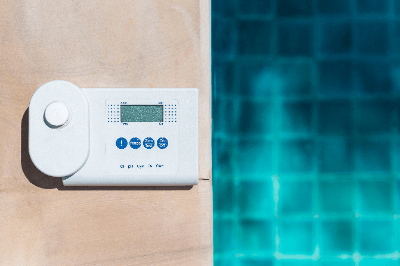What Is a Residual Chlorine Meter?
 A residual (amperometric) chlorine meter is a device to measure the amount of free effective chlorine and bound effective chlorine such as chloramine that remains in water after treatment with chlorinated chemicals at water purification plants.
A residual (amperometric) chlorine meter is a device to measure the amount of free effective chlorine and bound effective chlorine such as chloramine that remains in water after treatment with chlorinated chemicals at water purification plants.
It measures the amount of chlorine remaining in the water after 30 minutes of application of chlorine contracting agents, which are used to prevent the spread of waterborne diseases, it is indicated in units of ppm.
Residual chlorine has strong disinfecting power, but is almost completely eliminated in the drainage pipe. When residual chlorine is present to some extent, its disinfection effect can be maintained.
However, when residual chlorine is present in excessive amounts, it has a strong chlorine odor and corrodes metals and other materials.
It is also a well-known cause of the formation of carcinogens,
Therefore, it must be accurately measured for water quality control, daily inspections, and maintenance.
Uses of Residual Chlorine Meters
Residual chlorine meters are mainly used in public facilities, such as buildings, apartment buildings, schools, hospitals, community centers, and food and beverage factories, cooking facilities, swimming pools, elevated water tanks, and other places where water quality control is required.
Examples of use are as follows:
- Water quality control when drinking water is used as a raw material in food processes
- Pumping stations and distribution plants on the water pipeline network
- All process management of water treatment plants
- Management of plant and industrial water facilities (cooling water and drinking water)
- Water quality management of large boilers
- Deodorization equipment for human waste, sewage treatment plants, meat plants, etc.
- Principle of residual chlorine meter
There are three methods for measuring residual chlorine: the iodine titration method, the colorimetric DPD method, and the DPD absorbance spectrophotometric method, which uses reagents.
The polarograph method is a reagent-free method that measures conductivity by passing a weak electric current through a sensor using a precious metal electrode.
The iodometric titration method adds potassium iodide solution at a pH of 4 or less, after which the free and bound chlorine is replaced by iodine.
The reagent type method is used to measure total residual chlorine. The reagent form is used for process control in water purification plants.
The colorimetric DPD method and the DPD absorbance spectrophotometric method are:
- The DPD indicator is added to a sample and is oxidized by chlorine, resulting in a magenta coloration. The measurement is made by comparing the degree of coloration and reading the numerical value engraved on the colorimetric plate. This is the simplest method that can be easily performed at the measurement site.
- Residual chlorine meters using the polarograph method are made by applying a voltage of -0.4 V between a small rotating platinum electrode immersed in the sample and a stationary platinum electrode with a relatively large surface area.
- When a voltage of -0.4 V is applied between a small rotating platinum electrode immersed in the sample and a stationary platinum electrode with a relatively large area. Concentration polarization occurs on the surface of the rotating platinum electrode, and with a diffusion current corresponding to the amount of residual chlorine flows, the conductivity is expressed numerically.